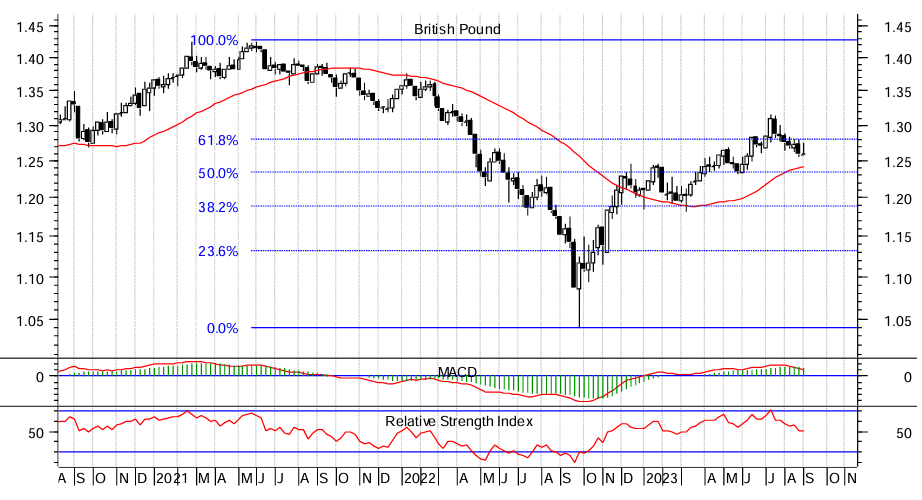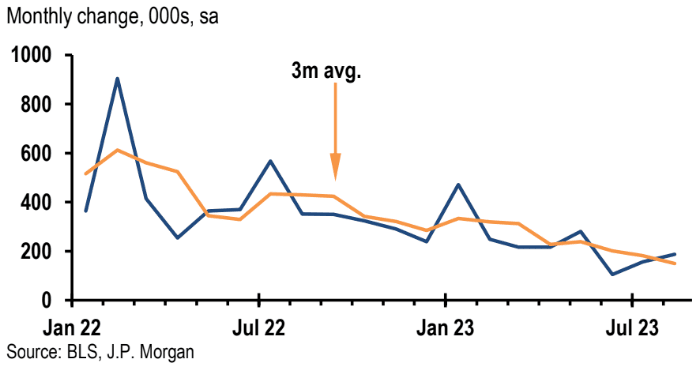GBP/USD Week Ahead Forecast: Scope for Further Weakness
- Written by: Gary Howes
-
- Technical studies advocate for softness
- U.S. ISM key U.S. release this week
- Bank of England MPC testimony in focus for GBP

Image © Adobe Images
The Pound to Dollar exchange rate initially rallied in the wake of last week's much-watched monthly job report but subsequently ended the day sharply lower; price action that underscores the difficulties of betting against the U.S. Dollar at present.
The jobs report was mixed with a better-than-expected increase in jobs for August balanced against a rise in the unemployment rate and softer-than-expected wages.
The report doesn't change the dial for Federal Reserve rate hike expectations (the market reckons the Fed has likely completed the hiking cycle), but this also means we are without a game-changer that would stop the ongoing Dollar recovery.
Looking at the Pound-Dollar charts confirms these broader trends with the exchange rate falling some 1.25% in August and September starting on a soft note.
Image courtesy of The Technical Trader.
Bill McNamara, an analyst who heads up The Technical Trader, says the weekly chart shows that the UK currency has been in retreat since it topped out at $1.313 in mid-July.
"Although it held its ground last week the fact that it retreated over the course of Thursday and Friday implies that there might be scope for further weakness in the near-term," he says in a regular weekly briefing.
He notes the closing low for August was at 1.2577 and the overall impression is that this level is likely to give way before too long.
"That being the case, the next area of possible support would be at around 1.242; if that doesn’t hold we could then see a reversion to the major low posted near the end of May, i.e. at 1.232 or so," says McNamara.
Pound-Dollar is primarily being driven by the U.S. Dollar side of the equation, a scenario that should extend this week given the empty UK data calendar.
Of note, however, is Wednesday's appearance of some the Bank of England's Monetary Policy Committee (MPC) members before Parliament's Treasury Select Committee, where they will be grilled on the latest developments concerning UK inflation and interest rates.
"Governor Bailey, Cunliffe, and Dhingra will testify to the Treasury Select Committee following the publication of the Aug MPR. While Dhingra will most likely stick to her dovish comments, it could be interesting to hear from Bailey and Cunliffe. We will in particular look for comments about how continued sharp upside surprises in wage growth might shape policy moving forward," says a note from TD Securities.
In keeping with Bank of England Chief Economist Huw Pill's latest comments, expect MPC members to indicate that inflation remains worryingly elevated to prompt further rate hikes, bolstering market expectations for another 25 basis point hike this September.
But at the same time, MPC members will tell parliamentarians that recent softer inflation data has been encouraging and this should ensure market pricing for a further hike in November remains less certain.
Any downshift in expectations for a November rate hike could weigh on the British Pound more generally.
The U.S. side of the GBPUSD equation is the dominant driver and this week's calendar focus rests on the midweek release of the ISM services index for August.
The market looks for a reading of 51, down on July's 52.3, with an undershoot having the potential to undermine the Dollar, and the opposite proving likely on any beat.
Above: Non-farm payrolls confirm a trend of falling jobs growth. Image courtesy of JP Morgan.
Ahead of last week's job report, the Dollar came under some pressure after U.S. job opening data showed a clear downward trend in the volume of vacancies.
"This led to markets scaling back the probability of additional Fed rate hikes in this cycle - there is now only a roughly 50% chance of a further 25bp rate hike priced in," says a note from Investec.
How the dial on this probability shifts in the wake of upcoming data will likely influence how U.S. bonds and the Greenback evolve over the coming days.
Recent inflation readings continue to suggest the U.S. inflation trend is returning closer to the Fed's target of 2.0% with the previous week's PCE report showing, for instance, that the headline price index was up 3.3% y/y and core at 4.2% y/y.
"Thus, we don’t think the data since the last FOMC meeting call for a monetary policy response and we believe the FOMC will hold rates at the current target range at the upcoming September meeting," says Michael Feroli, an economist at JP Morgan.













